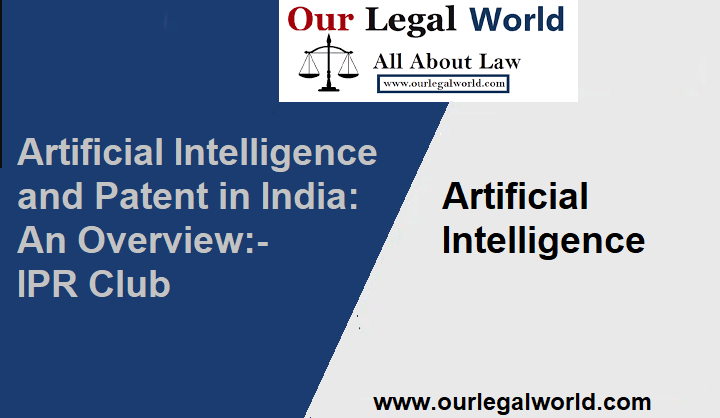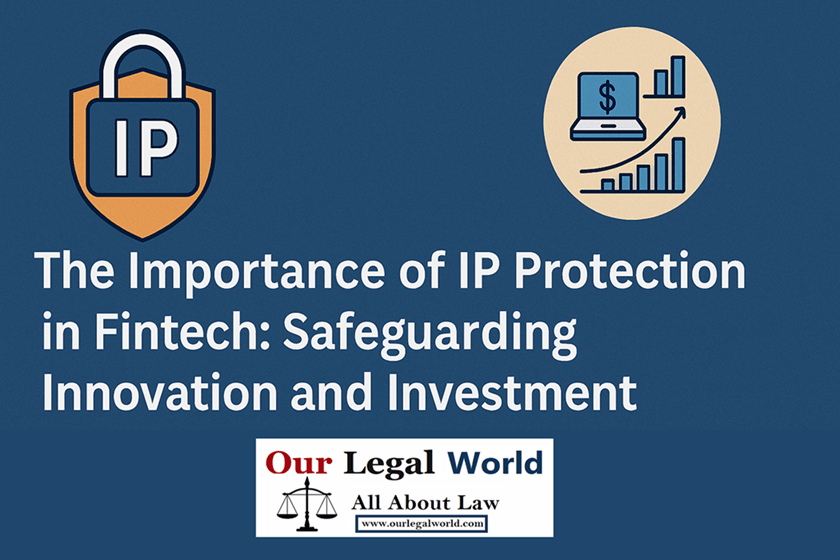Artificial Intelligence and Patent in India: An Overview:- IPR Club OurLegalWorld
INTRODUCTION
The creator has created human beings with a mix of emotions and intelligent quotient which distinguishes us from machines. In a world where we are depending on artificial intelligence for daily chores. Artificial intelligence in simple language is the ability of a computer or robot to do human work with inhabiting human intelligence and discernment. As it is said evolution has made the human brain so developed that the inventors can themselves create inventors as machines. According to a NASSCOM report, AI is expected to add USD 450-500 billion to India’s GDP by 2025[1]. This huge figure calls for regulation on the duties of AI but also the rights of AI. Here comes a question that is faced by the world right now. Should patent rights to AI be given to AI as inventors or to the human who created that AI?
Also Read: Protecting Entrepreneurial Copyright: Way Forward for the Indian Music Industry
THE WORLD VIEW
Patent law protects inventions by providing inventors with a monopoly over their inventions for a limited time in exchange for properly disclosing their inventions to the public[2]. Though this right comes with a lot of monetary benefits it has certain criteria to be cleared. In Indian law the right to patent is in the Patents (Amendment)Act, 2005 (hereinafter “the 2005 Act”) was India’s last step towards achieving complete TRIPS[3] compliance. The litmus test for any invention applicable for patent is novelty, invention, and capable of industrial application. To grant a patent to AI it may pass the novelty and industrial application criteria but when it comes to the invention it may be barred[4]. As under the Act in Section 2(ja) is defined as follows: 2. (a) “inventive step” means a feature of an invention that involves technical advance as compared to the existing knowledge or having economic significance or both and that makes the invention not obvious to a person skilled in the art[5]. To invent per se machines need to have cognitive and behavioural components like humans which they possess from antiquity like gigantic robots by Hephaestus[6], mechanical lions by Leonardo Da Vinci[7], and the latest being Sophia a humanoid citizen of Saudi Arabia[8]. But they all can do this work only because a set of systematic algorithms governs these AIs to form a brain and invent thus lacking creativity and originality or abstract idea category as stated by the US Supreme Court in Brenner v. Manson(1966)[9]. the similar was the case in Thaler v USPTO[10] where courts different countries [11]dismissed the patent application though classified DABUS as an inventor. But in Fitbit Inc. v AliphCom[12] the district court considered certain AI characteristics beyond the realm of abstract ideas this proves that it is not that AI cannot be granted patent rights at all. It certainly depends on its inventive criteria of it .
Also Read: International Intellectual Property Cases:- IPR Club OurLegalWorld
However, if we compare the theories of different countries the European Union went ahead with its contribution approach and claimed that the subject matter will have patent rights if they have a technical character where technical means were used to carry out non-technical activities[13]. In the United Kingdom of Great Britain, they come up with the idea where they thought that AI itself is not the single contributor to the invention. It has been supported by its owner thereby lacking naturalness and AI will not be deemed as an actual deviser of the invention[14]. However, we also need to differentiate between AI-generated inventions and AI-assisted inventions. There are many of them like Botto by Klingemann Mario[15], DeepBatch by computer scientists in Paris, France[16], Luhn algorithm used in Aadhar card[17] these all are AI-assisted inventions with human intervention and technology. But AI-generated invention is when Device and Method for the Autonomous Bootstrapping of Unified Sentience (DABUS) by Stephen Thaler is itself an AI generator and has filed 2 patent applications which were rejected but it is also the world’s first patent AI inventor by South Africa[18]. And also, there is also an inconsistency in what constitutes an invention in various countries this ambiguity is detrimental to everyone’s interest because the patent rights are global which was signed by 148 members including India in the 1970 Washington Patent Convention Treaty (PCT) supervised by World Intellectual Property Organization (WIPO)[19]. The mechanism of artificial intelligence is often inexplicable. Even computer scientists who write computer programs for artificial intelligence systems sometimes have difficulty explaining why and how their computer programs made an artificial intelligence system behave in a certain way. This reality conflicts with the de facto specificity requirement.
INDIA’S VIEW
Some certain countries have a clear idea about their perspective on AI patent rights. But if we talk about our own the laws are still ambiguous. Here first we need to come to the conclusion can a patent be given to non-natural persons. Though companies are considered legal entities when it comes to contracts under General Clauses Act 1972 but ultimately the right is given to the shareholders of the company where they are liable if any mishaps happen. But if we give inventorship to AI who will be liable if any adversity occurs? And also, who will claim all the merits of the invention? Because even if considered AI a human-like they are far away from us. AI is increasing in huge number replacing humans but this patent right development will give certain authority to them by law which can be destructive because we humans cannot predict ourselves then how will predict human-like creations? And we have created AIs to complement us not to replace us. But we can also not implement stringent India is a developing country where AI and start-ups are on the roll and more than half of the start-ups are AI-driven so even to increase the playing field it needs to formulate strategic patent policies which will not cost its GDP[20].
WAYS TO CLEAR THE CONFUSION
This all can be done by widening the horizon of the definition of inventors by including humans responsible for an AI invention. This allows us to take them responsible for any merit or demerit. Though the invention will be by the AI humans will be credited as the operator or programmer of it and have the inventorship. We can also have co-inventorship where the operator and AI both can be given patent rights where a third party can supervise its usage. The non-obviousness portion will be the challenging aspect; here, two factors may combine to assess the non-obviousness of a product or method. At this level, artificial intelligence and people with the actual expertise to assess how obvious a procedure or product is might possibly collaborate to make the optimal choice. In the test for obviousness, mosaicking which is prohibited in the novelty stage should be permitted. Novelty is all about a single prior art reference. However, to some extent, mosaicking is permitted to check the non-obviousness of a product or procedure. Both humans and artificial intelligence could work together to complete this. Together, we could overcome hindsight bias. Also, there should be uniformity in the patent laws around the world because it is right in rem. Though we have WIPO for it but interpretation and judgment vary across States which gives room for confusion for the whole.
CONCLUSION
The AI is transforming at an unknown pace. Laws are made and implemented according to global change. though there is a lot of confusion regarding the patent eligibility for an AI but jurisprudence under the laws of the USA, EU, and UK are clear about their approach towards the right though it is barring in nature. India is the target country for AI driven companies but there is a need for proper patent policies where the legislation defines and defends human interest in intellectual property. The inventions made by AI are made for humans’ utility so they need to be assessed and accepted on their own terms. But for the greed of human beings, we cannot kill the spirits of AI. Patent laws are under construction that needs to reward courageous and strenuous spectacular artificial intelligence. But keeping in mind that they are made by humans to aide them not rule over them.
Written by Manya Bansal (Author view is personal)
References
- Mizuki Hashiguchi, The Global Artificial Intelligence Revolution Challenges Patent Eligibility Laws, 13 J. Bus. & Tech. L. 1 (2017)
Available at: https://digitalcommons.law.umaryland.edu/jbtl/vol13/iss1/2
- Ballardini, R.M. (2019) “Ai-generated content: Authorship and inventorship in the age of Artificial Intelligence,” Online Distribution of Content in the EU, pp. 117–135. Available at: https://doi.org/10.4337/9781788119900.00015.
- Pheh Hoon Lim* and Phoebe Li (2022) “Artificial intelligence and inventorship: patently much ado in the computer program” Published by Oxford University PressAvailable at: Artificial intelligence and inventorship: patently much ado in the computer program | Journal of Intellectual Property Law & Practice | Oxford Academic (oup.com)
- Whalen, R. and Zingg, R. (2022) “Innovating under uncertainty: The patent-eligibility of Artificial Intelligence after Alice Corp. v. CLS Bank International,” SSRN Electronic Journal [Preprint]. Available at: https://doi.org/10.2139/ssrn.4099290.
- The Story of Artificial Intelligence and Patents by WIPO, available at: https://www.wipo.int/tech_trends/en/artificial_intelligence/story.html, visited on 15th July, 2021.
WIPO Technology Trends – Artificial Intelligence, available at: https://www.wipo.int/tech_trends/en/artificial_intelligence/#:~:text=WIPO%20Technology%20Trends%20%E2%80%93%20Artificial%20Intelligence&text=This%20first%20report%20in%20our,latest%20trends%20in%20the%20field., visited on 16th July, 2021. - DR. Kalyan C. Kankanala(2021) “ Artificial Intelligence(AI) Inventions and Patents”, Available at: https://www.bananaip.com/ip-news-center/artificial-intelligence-ai-inventions-and-patents/
[1] See https://nasscom.in/knowledge-center/publications/unlocking-value-data-and-ai-india-opportunity
[2][2] Kenneth W. Dam, The Economic Underpinnings of Patent Law, 23 J. LEGAL STUD. 247, 248, 270–71 (1994).
[3] See https://www.wto.org/english/tratop_e/trips_e/intel2_e.htm
[4] (2012) PL (IP) May 64
[5] See Patent Act 1970
[6] See Association for the Advancement of Artificial, supra note 60; see also Hephaestus and the Creation of the Robots, supra note 60; see generally Hephaistos, THEOI GREEK MYTHOLOGY, https://www.theoi.com/ Olympios/Hephaistos.html Talos, THEOI GREEK MYTHOLOGY, https://www. theoi.com/Gigante/GiganteTalos.html .
[7] See Pride of Da Vinci’s Genius Walks Again After 500 years, INDEPENDENT (July 3, 2009, 6:00 PM), https://www.independent.co.uk/arts-entertainment/art/features/pride-of-da-vincis-genius-walks-again-after-500- years-1731269.html.
[8] See https://www.hansonrobotics.com/sophia/
[9] 383 U.S. 519 (1966)
[10] Thaler v USPTO Case 1:20-cv-00903-LMB-TCB (USDC 2021).
[11] Thaler v Comptroller-General of Patents, Designs and Trade Marks [2021] EWCA Civ 1374, Thaler v Commissioner of Patents [2021] FCA 879. , Thaler v Comptroller General of Patents, Designs and Trade Marks (n 3) [1].
[12] Fitbit Inc. v. AliphCom, No. 16-cv-00118-BLF (N.D. Cal. Mar. 2, 2017).
[13] Decision of the European Patent Office, Technical Board of Appeal, Case T 258/03 – 3.5.1, Reasons for the Decision ¶¶ 3.3, 4.3.(Apr.21,2004), https://www.epo.org/law-practice/case-law-appeals/ pdf/ t030258ep1.pdf.
[14] Patents Act 1977 (UK), s 7(3).
[15] https://www.botto.com/
[16] GAËTAN HADJERES & FRANÇOIS PACHET, DEEPBACH: A STEERABLE MODEL FOR BACH CHORALES GENERATION 1 (Jun. 17, 2017),arxiv.org/pdf/1612.01010v2.pdf.
[17]https://cleartax.in/g/terms/luhnalgorithm#:~:text=A%20Luhn%20algorithm%20is%20used,numbers%2C%20such%20as%20Aadhaar%20number.
[18] https://brandequity.economictimes.indiatimes.com/news/digital/meet-dabus-the-worlds-first-ai-system-to-be-awarded-a-patent/85149000
[19] https://www.wipo.int/pct/en/
[20] https://www.hindustantimes.com/business/the-rise-of-indian-startups-with-focus-on-innovation-101633307015141.html








